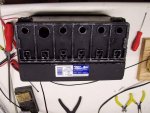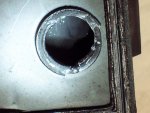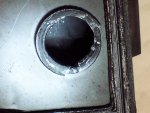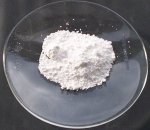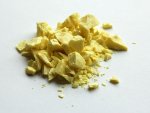In for results of your tests. BUT I just watched your video and I think you have a severe misunderstanding of the chemistry of LA batteries. For one thing those crystals (white powder) that you show in your photos above are not sulphur, they're most likely Lead Sulphate. Sulphur is yellow and there should be NO free sulphur in or on a LA battery, under any circumstances. In the video at around the twelve minute mark you also made frequent mention of the plates in the battery being coated with sulphur. That's incorrect, they actually get coated with Lead Sulphate. In a discharged battery, the Sulphuric acid electrolyte reacts with the plates (Lead Peroxide and pure Lead) and converts them to Lead Sulphate and the acid converts to water. That's why the electrolyte in discharged batteries has a low density, the heavier acid has been converted to lower density water. Lead Sulphate is also an insulator so when the plates are covered in it you effectively have an open circuit. The open circuit prevents any current from flowing out of or into the battery. in other words, the battery can't supply any current nor will it accept a charge. Which brings me to something else about your video. In it you show the battery drawing 30 amps when you connect it to the charger. If it had even one sulphated cell, it would draw little or no current! It looked to me, like you may have had one shorted cell IF anything was wrong with that battery. A shorted cell would also explain why there was no bubbling in that cell. Since it's shorted there would be no voltage available in that cell to break down the water into bubbles. If you had a sulphated cell, then little or or no current would flow in ANY of the cells (since they're connected in series) and you wouldn't get any bubbling in ANY of the cells. In addition, in a battery with a shorted cell, the other cells will bubble excessively since now the charging voltage is applied over only five cells instead of six! And excessive voltage in a cell will cause it to break down the water into hydrogen and oxygen instead of just charging the cell. IMO you need to drill through the top of the case and get to the straps that connect the cells together inside of the battery and measure each cell individually instead of in a series so that you can tell exactly what's going on with each cell.
If you want to send me one of your devices, I'll be happy to try it out on some batteries that have been sitting unused for several years so I'm sure they're heavily sulphated. I also have plenty of test equipment including dummy power loads, HP digital storage O'scopes (HP 54510s), high accuracy HP (and others) meters, HP recording multimeters and piles of HP, Lambda and other CV/CC power supplies up to 4500 volts and 150 amps.
FWIW I think your pulse charging idea to recover sulphated batteries has merit. The problem is that the cells in a battery are connected in series internally. That means that you can't access just one cell for testing or charging without going though the other five cells! As you noted in your video anything that you do to try and rejuvenate a bad cell is going to affect the other cells and in most cases they are going to mitigate what ever method you try to use. I think the only effective method to recover a bad cell is going to require that someone cut or drill into the case to access both terminals of the affected cell directly so that it can be operated on directly and without affecting the other cells.





